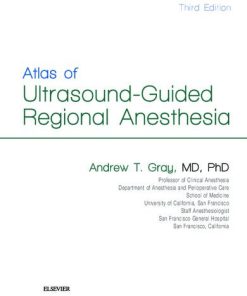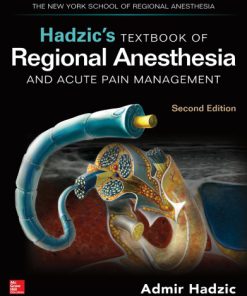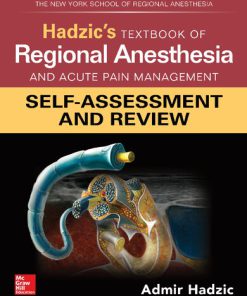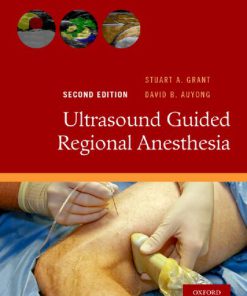Complications of Regional Anesthesia Principles of Safe Practice in Local and Regional Anesthesia 3rd Edition by Brendan Finucane ISBN 3319493868 9783319493862
$50.00 Original price was: $50.00.$25.00Current price is: $25.00.
Complications of Regional Anesthesia Principles of Safe Practice in Local and Regional Anesthesia 3rd Edition by Brendan T. Finucane – Ebook PDF Instant Download/Delivery: 3319493868, 9783319493862
Full download Complications of Regional Anesthesia Principles of Safe Practice in Local and Regional Anesthesia 3rd Edition after payment
Product details:
ISBN 10: 3319493868
ISBN 13: 9783319493862
Author: Brendan T. Finucane
Reflecting the rapid growth of pain medicine and of ultrasound as a tool, this Third Edition is more comprehensive and inclusive than previous editions and features additional pages, tables, diagrams, and color illustrations. In addition to the discipline of Anesthesiology, other specialists, who use local and regional anesthesia techniques, (surgeons, ophthalmologists, emergency medicine physicians and dentists), have also contributed to this edition of the book. Complications of Regional Anesthesia, with its newly added subtitle, Principles of Safe Practice in Local and Regional Anesthesia, stresses the relatively new emphasis and importance on safety and prevention and broadens the discussion to include the practice and administration of not just regional but also local anesthesia. Each chapter has been thoroughly revised, brought up-to-date, and features full color images. Individual chapters cover complications associated with specific nerve blocks; IV and catheter methods; obstetric regional anesthesia; pediatric regional anesthesia; ophthalmic regional anesthesia; and treatment of acute and chronic pain.
Complications of Regional Anesthesia Principles of Safe Practice in Local and Regional Anesthesia 3rd Table of contents:
Part I: General Considerations
1: The History of Local and Regional Anesthesia
Definitions
The Discovery of Local Anesthetics
Evolution of Local Anesthetics
The Birth of Regional Anesthesia
The Discovery of Spinal Anesthesia by Bier
Evolution of Regional Anesthesia
Intravenous Regional Anesthesia (The Bier Block)
Regional Anesthesia-Pre-emptive Analgesia
Peripheral Nerve Blockade
Epidural Anesthesia
Development of Regional Anesthesia Post WW II
Regional Anesthesia in the Modern Era
Summary
References
2: Regional Anesthesia Safety
Introduction
Complication Anticipation: Recognizing Precipitating Factors
The Preoperative Assessment: Patient History
The Nervous System
The Respiratory System
The Cardiovascular System
The Gastrointestinal Tract
The Hematologic System
Clotting Mechanisms
“Histaminoid” Reactions
Pseudocholinesterase Dysfunction
Methemoglobinemia
Muscle Disease
Diabetes
Miscellaneous Medications
Aspirin
Quinidine and Disopyramide
Benzodiazepines
Verapamil
Nifedipine
The Preanesthetic Visit: Physical Examination
Conclusion
Equipment
Spinal Needles
Clinical Reports
Laboratory Reports
Changing the Needle Direction During Insertion
Resistance to Penetration of the Dura Mater
Detection Time for CSF After Dural Puncture
Rate of CSF Leak Following Dural Puncture
Needle Orifice Shape and Unintended Extra Dural Injection
Epidural Needles
Tuohy Needle
Crawford Needle
Whitacre Needles
Combined Spinal and Epidural Techniques
Double-Lumen Needles
Flow Characteristics of Long Spinal Needles
Catheter Migration
Complications Associated with Spinal and Epidural Catheters
Devices for Peripheral Nerve Blockade
Resuscitation Supplies
Behavioral Factors and Complications
Effects of Sleep Deprivation
The Effects of Fatigue
The Hazard of Boredom
The Influences of Physical and Mental Factors
Work Environment
Complication Recognition During Neural Blockade and Surgery
Sharing Human and Instrumental Monitoring
Monitoring Devices
Pulse Oximetry [100–106]Capnography [109–112]Cardiac Rate and Rhythm
Systemic Arterial Pressure
Manual Indirect Measurement of Blood Pressure
Automated Oscillometric Measurement
Plethysmography
Thermometrography
Conclusion
Complications of Specific Neural Blockades
Airway Obstruction
Local Anesthetic Focal Complications
Epinephrine Complications
Complications of Neural Blockade
Miscellaneous Neural Blockade Complications
Complications in the Postoperative Period
Admitting the Patient: History and Physical Examination
Monitoring the Patient
Discharging the Patient
Complication Prevention
Patient Monitoring
Epidural Anesthesia During Childbirth
Practice of Anesthesia Outside a Hospital
Patient Selection
Preoperative Considerations
Conduct of Anesthesia
Conclusion
References
3: Local Anesthetic Toxicity: Prevention and Management
Introduction
Incidence
History
Structure and Properties of Local Anesthetics
Onset of Action, Potency, and Duration
Mechanism of Action
Pharmacokinetic Considerations
Absorption
Distribution
Plasma Protein Binding
Hepatic Metabolism
Renal Excretion
Clinical Presentation
Central Nervous System Toxicity
Cardiac Toxicity
Treatment of Toxicity
Intralipid Emulsion
Advanced Cardiac Resuscitation
Prevention of Toxicity
Dosing
Abdominal Wall Blocks
Intravenous Lidocaine Infusion
Sustained Release Local Anesthetic Formulations and Myotoxicity
Summary
References
4: Outcome Studies Comparing Regional and General Anesthesia
Introduction
Neuraxial Blockade for Major Surgery
Neuraxial Blockade for Hip or Knee Surgery
Postoperative Delirium and Postoperative Cognitive Dysfunction
Cancer Recurrence Postsurgery
Peripheral Nerve Blockade and Ambulatory Anesthesia
Conclusion
References
Part II: Special Considerations
5: Nerve Injury Resulting from Intraneural Injection When Performing Peripheral Nerve Block
Introduction
Search Strategy and Selection of Studies
Literature Selection
Evidence Evaluation
Incidence of Neurologic Complications Following PNB
Lessons from Case Reports
Analyzing Neurologic Injury from the Perspective of Disease Causation
Epidemiological Triangle
Host/Biological Factors
Anatomy and Physiology
Surgical Factors
Neuropathy
Causative Agent Factors
Mechanical Agents
Needle Trauma
Pressure Injury
Chemical Agents
Neurotoxicity
Adjuvants
Intraneural Injections
Environmental Influences
Nerve Stimulation
Injection Pressure Monitoring
Ultrasound
Pathophysiology
Practical Points in Mechanism of Nerve Injury
Conclusion
References
6: Regional Anesthesia in the Presence of Neurologic Disease
Introduction
General Considerations
Regional Anesthesia and Multiple Sclerosis
Regional Anesthesia and Amyotrophic Lateral Sclerosis
Regional Anesthesia and Spinal Cord Injuries
Regional Anesthesia and Post-polio Syndrome
Regional Anesthesia and Peripheral Neuropathies
Regional Anesthesia and Guillain–Barré Syndrome
Regional Anesthesia and Myotonic Dystrophy
Regional Anesthesia and Myasthenia Gravis
Conclusion
References
7: Evaluation of Neurologic Injury Following Regional Anesthesia
Introduction
History
Identifying the Complication
Preexisting Conditions
Surgical Events
Anesthetic Events
Development of Neurologic Dysfunction
Physical Examination
General Examination
Neurologic Examination
Mental Status/Cranial Nerves
Motor Examination
Sensory Examination
Reflexes
Coordination/Gait
Electrodiagnostic Evaluation
Nerve Conductions
Motor Conductions
Late Responses
Sensory Conductions
Limitations of Nerve Conduction Studies
Electromyography
Limitations and Benefits of EMG
Practical Approach
Imaging
Plain Films
Computed Tomography
Technology
Limitations
Indications
Magnetic Resonance Imaging
Technology
Limitations
Indications
Magnetic Resonance Neurography (MRN)
Conventional Angiography
Technology
Limitations
Indications
Noninvasive Angiography
Technology
Limitations
Indications
Ultrasound
Technology
Limitations
Indications
Imaging of Complications of Regional Anesthesia
Integration
References
8: Regional Anesthesia and Anticoagulation
Introduction
Bleeding Complications
Quantifying Risk
Pharmacologic Anticoagulation
Nonsteroidal Anti-inflammatory Drugs
Aspirin
Nonaspirin NSAIDs
Warfarin
Heparins
ADP Receptor Blockers
Newer Anticoagulants
Additional Agents Effecting Coagulation
Conclusions
References
9: Infection in Association with Local and Regional Anesthesia
Introduction
Epidemiology of Meningitis and Epidural Abscess
Meningitis and Epidural Abscess After Neuraxial Anesthesia
Neuraxial Blockade in the Febrile or Infected Patient
Meningitis After Dural Puncture
Meningitis After Spinal and Epidural Anesthesia
Epidural Abscess After Epidural Anesthesia
Special Considerations in the Parturient
Herpes Simplex Virus
Human Immunodeficiency Virus (HIV)
Neuraxial Blockade in the Immunocompromised Patient
Aseptic Technique
Hand Washing, Masks, and Gowns
Skin Disinfection
Preparation of Injectate and Infusate
Catheter Disconnects and Other Breaks in the Circuit
Anesthetic Management
Diagnosis and Treatment of Neuraxial Infectious Complications
Infectious Complications of Peripheral Regional Techniques
Anesthetic Management
Diagnosis and Treatment of Peripheral Infectious Complications
References
10: Continuous Peripheral Nerve Blocks Safe Practice and Management
Introduction
Technique of CPNB Insertion
Patient Preparation
Needle Choice
Catheters
Catheterization Kits
Nerve Localization Technique
Paresthesias and Tactile Feedback
Electrical Nerve Stimulation
Catheter Advancement and Tip Localization Using Electrical Stimulation
Ultrasound Guidance for Catheter Insertion
Needle In-plane, Nerve in Short-Axis Approach
Needle Out-of-Plane, Nerve in Short-Axis Approach
Needle In-plane and Nerve in Long-Axis Approach
Ultrasonographic Catheter Tip Localization
Complications of Continuous Peripheral Nerve Blocks
Inaccurate Catheter Tip Placement
Catheter Dislocation
Infectious Complications of CPNBs
Complications of Catheter Removal
Neurological Complications
Accidental Vascular Puncture and Hematoma Formation
Local Anesthetic Toxicity
Other Complications
CPNB’s and Acute Compartment Syndrome
Phrenic Nerve Palsy
Falls
Optimal Infusion Regimen for Perineural Infusions
Summary
References
Part III: Specific Regional Blocks: Safe Practice and Management of Adverse Events
11: Complications of Regional Anesthesia: Upper and Lower Extremity Blockade
Peripheral Nerve Injury
Direct Trauma
Chemical Neurotoxicity
Other Factors
Incidence
Diagnosis and Management
Prevention
Local Anesthetic Toxicity
Upper Extremity Block Procedures
Block Site Specific Complications
Interscalene
Supraclavicular
Infraclavicular
Axillary
Lower Extremity Block Procedures
Block Site Specific Complications
Lumbar Plexus/Psoas Compartment
Femoral
Saphenous (Adductor Canal)
Proximal Sciatic
Popliteal Sciatic
Intravenous Regional Anesthesia
Overview
References
12: Complications of Thoracic Wall Regional Anesthesia and Analgesia
Introduction
Thoracic Epidural
Thoracic Spine Anatomy
Neural Blockade
Classical Technique
Ultrasound Guidance
Complications/Treatment
Paravertebral Nerve Blocks
Paravertebral Anatomy
Paravertebral Nerve Block Technique
Classic Technique—Lateral Approach
Medial Approach
Continuous Technique
Ultrasound-Guided Paravertebral Nerve Block
Complications/Treatment
Intercostal Nerve Blocks
Intercostal Anatomy
Intercostal Nerve Block Techniques
Posterior Approach
Lateral Approach
Continuous Technique
Ultrasound-Guided Intercostal Nerve Block
Complications/Treatment
Interpleural Analgesia
Pleural Anatomy
Interpleural Block Technique
Complications/Treatment
Thoracic Wall Nerve Block
Anterior Thoracic Wall Anatomy
Thoracic Wall Block Techniques
Complications/Treatment
Summary
References
13: Abdominal Wall Blocks: Safe Practice and Management of Adverse Events
Introduction
Key Risks and Complications
Abdominal Wall Trauma
Trauma to Intra-abdominal Structures
Femoral Nerve Block
Local Anesthetic Toxicity
Special Cases
Morbid Obesity
Pediatrics
Pregnancy
Coagulopathy
Summary
References
14: Epidural Blockade: Safe Practice and Management of Adverse Events
Introduction
Benefits of Epidural Blockade in Special Patient Populations
Infrastructure for Safe Epidural Blockade
Training in Epidural Techniques
Risks of Epidural Anesthesia
Coincidental Causes of Neurologic Injury
Serious Neurological Complications of Epidural Anesthesia
Risk Factors for Neurologic Injury
Diagnosis of Neurologic Injury
Intravertebral Hematoma
Etiology
Incidence
Diagnosis and Treatment
Prevention
Acceptable Laboratory Values for Safe Institution of Epidural Blockade
Unfractionated Heparin and LMWH
Oral Anticoagulants
Antiplatelet Agents
Intravertebral Abscess and Meningitis
Prevention
Spinal Cord Ischemia and Infarction
Spinal Cord and Nerve Root Trauma
Arachnoiditis and Neurotoxicity
Etiology
Wrong Drug and Wrong Route Errors
Local Anesthetic Systemic Toxicity (LAST)
Special Populations: Obstetric
Special Populations: Pediatric
Special Populations: Chronic Pain
Summary
References
15: Spinal Anesthesia: Safe Practice and Management of Adverse Events
Introduction
Technique
Failure of Spinal Anesthesia
Hemodynamic Complications
Hypotension
Bradycardia
Treatment and Prevention of Hypotension and Bradycardia
Nausea and Vomiting
Cardiac Arrest
Urinary Retention
Urinary Retention and Outpatient Surgery
Transient Neurologic Problems
Radiculopathy
Backache
Transient Neurologic Symptoms (TNS)
Etiology
Identification of Risk Factors
Clinical Implications
Postdural Puncture Headache (PDPH)
Definition
Etiology
Treatment
Epidural Blood Patch (EBP)
Pruritus
Continuous Spinal Anesthesia
Conclusion
References
Part IV: Specific Patient Populations: Safe Practice and Management of Adverse Events
16: Complications of Regional Anesthesia in Chronic Pain Therapy
Introduction
Sympathetic Blocks
Stellate Ganglion Block
Complications
Needle Trauma
Intravascular Injection
Intraspinal Injection
Anomalous Spread of Drug
Drug Effects
Thoracic and Lumbar Sympathetic Blockade
Complications
Intraspinal and Intravascular Injection
Needle Trauma
Drug Effects
Intravenous Regional Sympathetic Block
Complications
Drug Effects
Visceral Nerve Blocks
Celiac Plexus Block
Complications
Hypotension
Diarrhea
Needle Trauma
Infection
Neurologic and Neurovascular Sequelae
Drug Effects
Pelvic Visceral Nerve Blocks
Somatic Nerve Blocks
Facet Joint Block
Complications
Increased Pain
Infection
Intraspinal Injection
Other Complications
Facet Joint Radiofrequency Denervation
Complications
Epidural Blockade
Complications
Neurotoxicity
Neurologic Injury
Infection
Dural Puncture
Systemic Side Effects of Steroids
Systemic Side Effects of Epidural Opioid
Other Complications
Neural Ablative Procedures
Neuropathic Effects of Neurolytic Agents
Neurologic Complications
Motor Paresis
Loss of Bladder and Bowel Control
Postblock Pain
Implantable Catheters and Drug Delivery System
Complications
Neurological Injury
Infection
Drug-Related Complications
Device-Related Complications
Inflammatory Mass
Miscellaneous
Spinal Cord Stimulation
Complications
References
17: Local and Regional Anesthesia in the Elderly
Introduction
Regional Anesthesia in the Elderly
Sedation for Regional Anesthesia
Benzodiazepines
Midazolam
Lorazepam
Opioids
Remifentanil
Other Sedatives
Dexmedetomidine
Ketamine
Propofol
Local Anesthetics
General Considerations
Systemic Absorption
Distribution
Clearance
Clinical Implications
Peripheral Nerve Block
Anatomic and Physiologic Considerations
Clinical Observations
Adjuvant Epinephrine
Central Neuraxial Block (Spinal and Epidural Analgesia)
General Pharmacokinetic Considerations
Epidural Anesthesia
Anatomic and Physiologic Considerations
Clinical Observations
Adjuvant Epinephrine
Adjuvant Opioids
Spinal Anesthesia
Anatomy and Physiological Considerations
Clinical Observations
Adjuvant Epinephrine
Adjuvant Opioids
Conclusion
References
18: Local and Regional Analgesia for Labor and Delivery
Introduction
Incidence of Adverse Events
Hypotension
Local Anesthetic Toxicity: Maternal Rescue with Lipid
Local Anesthetic Toxicity: Fetal Bradycardia
The Use of Paracervical Blocks
The Use of Pudendal Nerve Block
Neurological Dysfunction in the Obstetric Patient
Obstetric Palsies
Preventing Spinal–Epidural Hematoma
Infection (Meningitis/Epidural Abscess)
Chronic Adhesive Arachnoiditis
Postdural Puncture Headache
Cauda Equina Lesion
Cord Damage
Transient Neurological Symptoms
Inadequate Block for Vaginal Delivery and Cesarean Section
Extensive Block
Respiratory and Cardiac Arrest
Conclusion
References
19: Local and Regional Anesthesia in the Obese Patients
Introduction
Classification of Obesity
Respiratory Considerations
Cardiovascular Considerations
Pharmacology
Effect of Obesity
Sedation
Local Anesthetics
Lipid Rescue Therapy
Neuraxial Anesthesia
Epidural
Difficult Placement
Accidental Dural Puncture
Postdural Puncture Headache
Intravascular Puncture
Catheter Migration
Hypotension
Dose Selection
Spinal Anesthesia
Difficult Placement
Hypotension
Cerebrospinal Fluid Volume and Dose Selection
Combined Spinal-Epidural
Peripheral Nerve Blocks
Brachial Plexus
Lower Extremity Blocks
Transverse Abdominis Plane Block
Catheter Site Infections
Conclusion
References
20: Local and Regional Anesthesia in Pediatrics
Introduction
Evidence-Based Safety Records of Pediatric Regional Anesthesia
Specific Complications of Regional Anesthesia in Children
Neural Injury
Epidural Hematoma
Dural Puncture
Assessment of Catheter Tip Placement
Local Anesthetic Systemic Toxicity (LAST)
Infection
Compartment Syndrome
Impact of Ultrasound Guidance on Complications in Regional Anesthesia in Children
Author’s “Pediatric Common Sense” Safety Considerations
References
Part V: Special Environments: Safe Practice and Management of Adverse Events
21: Local and Regional Anesthesia in Dental and Oral Surgery
Introduction
Dental Local Anesthetic Formulations
Articaine
Bupivacaine
Lidocaine
Mepivacaine
Prilocaine
Techniques of Dental Local Anesthesia
Maxillary Injection Techniques
Supraperiosteal (Infiltration) Injection
Anterior Superior Alveolar Nerve Block
Middle Superior Alveolar Nerve Block
Posterior Superior Alveolar Nerve Block
Greater Palatine Nerve Block
Nasopalatine Nerve Block
Maxillary (V2) Nerve Block
Mandibular Injection Techniques
Inferior Alveolar Nerve Block
Gow-Gates Mandibular Nerve Block
Vazirani–Akinosi Nerve Block
Incisive (Mental) Nerve Block
Supplemental Injection Techniques
Periodontal Ligament Injection
Intraosseous
Local Complications of Local Anesthetic Administration
Needle Breakage
Paresthesia
Transient Facial Nerve Paralysis
Self-Inflicted Soft Tissue Injury
Systemic Complications
Toxicity (Overdose)
Allergy to Local Anesthesia
Future Considerations
Computer-Controlled Local Anesthetic Delivery (C-CLAD)
Phentolamine Mesylate: Reversal of Local Anesthesia
Buffered Local Anesthetics
Intranasal Local Anesthetic Mist
Summary
References
22: Local and Regional Anesthesia in the Emergency Room
Introduction
Scope of Regional Anesthesia Practice in the Emergency Department
Fracture Hematoma Blocks
Promoting Regional Anesthesia Safety and Efficiency with an Emergency Department Block Cart
Emergency Department Regional Anesthesia Documentation
Strategies for Emergency Department Communication and Documentation
Appropriate Local Anesthetic Selection
Avoiding a Prolonged Block
Avoiding a Premature Resolution of the Block
Avoiding Local Anesthetic Toxicity
Reducing Risk of Nerve Injury with Appropriate Needle Selection
Preexisting Neurologic Injury
Reducing Unnecessary Delay
Strategies to Promote the Timely Utilization of Regional Anesthesia in the Emergency Departmen
Unique Patient Considerations in the Emergency Setting
The Intoxicated Patient
Potential Risks Associated with Performing Regional Anesthesia in an Intoxicated Patient
Reducing the Risks Associated with Intoxicated Patients
Consider Moderate or Deep Sedation as Alternative to Regional Anesthesia
Consider Judicious Use of Light Sedation
Consider Delaying Regional Anesthesia
The Patient in Acute Withdrawal
Alcohol Withdrawal Treatment Options
Opioid Withdrawal Treatment Options
Sympathomimetic Treatment Options
Summary
References
23: Recognizing and Mitigating Risk of Ophthalmic Regional Anesthesia
Introduction
Optimal Management of Patients Undergoing Ophthalmic Regional Anesthesia
Complications of Ophthalmic Regional Anesthesia
Hemorrhage
Brainstem Anesthesia
Globe Penetration and Perforation
Strabismus
Effects on Ocular Circulation
Optic Nerve Damage
Pupillary Anomalies
Therapeutic Misadventures (Including Systemic Toxicity)
Seventh Nerve Block Complications
Allergy
Anticoagulants and Antiplatelet Therapy
Alternative Methods of Ophthalmic Anesthesia
Summary and Current Practice of Anesthesia for Cataract Surgery
Sub-Tenon’s Anesthesia
References
24: Local Infiltration Analgesia for Orthopedic Joint Surgery
Introduction
Historical Perspective
Surgeon’s Perspective: Local Infiltration Anesthesia in Total Knee Arthroplasty
Why Is LIA Popular for Arthroplasties and Can It Be Used for All Joint Surgeries?
Anatomical Consideration
Innervation of the Hip Joint
Innervation of the Knee Joint
Equipment and Technique of Injection
Composition of LIA
Practical Consideration
LIA in Total Hip Arthroplasty [56]LIA in Total Knee Arthroplasty [53, 57]LIA in Arthroscopy Surgeries
Clinical Evidence
Hip Arthroplasty
Total Knee Arthroplasty (TKA)
Non-analgesia Benefits of LIA in Lower Limb Arthroplasty Surgeries
An Institutional Experience of Implementing LIA to Analgesic Paradigm
Continuous Catheter Techniques
Incidence and Management of Complications and Adverse Events from LIA
Chondrotoxicity [77–83]Shoulder Surgery and Glenohumeral Chondrolysis
Risk of Infection
Practice Points to Minimize the Risk of Infections
Nerve Injury
Vascular Puncture
Local Anesthetic Systemic Toxicity (LAST)
Practice Points to Minimize LAST in the Context of LIA
Impact on Wound Healing/Revision Surgery
Future Directions
Conclusion
References
25: Local and Regional Anesthesia in Plastic Surgery: Safety Considerations and Management of Ad
Introduction
Local and Regional Anesthesia in Liposuction (Tumescent Anesthesia)
Tumescence Liposuction Combined with Local and Regional Anesthesia in Plastic Surgery
Local and Regional Anesthesia in Abdominoplasty
Local Anesthesia in Hand Surgery
Local Anesthesia in Face Lift
Regional Anesthesia in Plastic Surgery
Complications of Local and Regional Anesthesia in Plastic Surgery
Central Neural Blockade Following Local and Regional Anesthesia in Plastic Surgery
Toxicity of Long-Acting Local Anesthetics in Plastic Surgery
Cardiotoxicity of Local Anesthetics in Plastic Surgery
Vascular Complications of Local and Regional Anesthesia in Plastic Surgery
Horner Syndrome Following Local and Regional Anesthesia in Plastic Surgery
Failure of Local Anesthesia and Regional Anesthesia in Plastic Surgery
Nerve Injury Following Local and Regional Anesthesia in Plastic Surgery
Accidental Injection of the Wrong Local Anesthetic Solution in Plastic Surgery
Pneumothorax After Local/Regional Anesthesia in Plastic Surgery (Breast Surgery)
Complications of Local Anesthesia in Face Lift
Allergic Reactions of Local Anesthetics in Plastic Surgery
Complications of Local Anesthesia Infusion Pain Pumps in Plastic Surgery
Toxicity of Topical Anesthetics in Plastic Surgery
Deaths Related with Local and Regional Anesthesia in Plastic Surgery
Prevention of Local Anesthetic Systemic Toxicity in Plastic Surgery
General Considerations for the Treatment of Toxic Reactions of Local Anesthetic in Plastic Sur
Conclusion
References
Part VI: Morbidity Studies: International Perspective
26: Development and Methodology of a Registry of Regional Anaesthesia
Introduction
The Australasian Regional Anaesthesia Collaboration
The Registry Imperative
Definition of a Clinical Registry
Advantages and Limitations of Clinical Registries
Challenges in Managing a Clinical Registry
Data Elements, Definitions and Quality Control
Development of an International Registry of Regional Anesthesia
References
27: Australia: Results of a Multicenter Registry of Regional Anesthesia
Neurological Complications
Preliminary Results of the Australasian Regional Anaesthesia Collaboration
Results from the Australian and New Zealand Registry of Regional Anaesthesia
Local Anesthetic Systemic Toxicity
Preliminary Results of the Australasian Regional Anaesthesia Collaboration
Results from the Australian and New Zealand Registry of Regional Anaesthesia
Respiratory Outcomes, Wrong-Site Block, Other Outcomes and Trends
Summary
References
28: Canada: Medical Legal Aspects of Regional Anesthesia Practice
Introduction
Legal Actions Against Anesthesiologists in Canada
Disabilities and Legal Outcome
Claims Experience in Regional Anesthesia
Analysis of Regional Anesthesia Claims over a 20-Year Period
Neuraxial Blocks
Epidural Blocks
Spinal Anesthesia
Other Types of Anesthetic Blocks
Obstetric Anesthesia and Analgesia
Cost of Litigation
Legal Issues
Conclusion
References
29: France: Regional Anesthesia Morbidity Study
Introduction
SOS Regional Anesthesia Service
Cardiac Arrest
Local Anesthetic Systemic Toxicity (LAST)
Neurologic Complications
Limitations of Reporting Systems
A Systems Analysis Approach
Conclusion
References
30: Nordic Countries: Principles of Safe Practice in Local and Regional Anesthesia
Introduction
Spinal Hematomas
Infections
Neuraxial Morbidity, Conclusion
Local Anesthetic Systemic Toxicity
References
31: United Kingdom: Recent Advances in the Safety and Prevention of Regional Anesthesia Complica
Introduction
Inadvertent Local Anesthetic Injection
Wrong Site Block
Efficacy and Side Effects of Central Neuraxial Block
Denominator
Numerator
Strengths and Weaknesses
National Coordination
The Role of Regional Anesthesia in Hip Fracture Surgery
Patient Satisfaction
Conclusion
References
32: United States: Complications Associated with Regional Anesthesia (An American Society of Anest
Introduction
Complications Associated with Regional Anesthesia
Overview
Neuraxial Cardiac Arrest
High Block/Total Spinal Block
Local Anesthetic Systemic Toxicity
Nerve Injuries Associated with Peripheral Nerve Blocks
Injuries to the Neuraxis
Eye Injuries in Regional Anesthesia Claims
Claims for Regional Anesthesia: The Role of Consent and Communication
Conclusions
References
33: United States: Chronic Pain Management (American Society of Anesthesiologists’ Closed Claims
2004: Chronic Pain Management
1970–1989
1990–1999
Summary of the 2004 Chronic Pain Management Analysis [1]Analysis of More Severe Outcomes from the 2004 Study
Conclusions from the 2004 Study
2011: Injury and Liability Associated with Cervical Procedures for Chronic Pain
2016: Injury and Liability Associated with Implantable Devices for Chronic Pain
Findings (148 Claims in Database of 10,545)
Types of Injuries Related to Implantable Devices
Damaging Events
Recommendations
Conclusion
References
Part VII: Medical Legal Aspects
34: Medical Legal Aspects of Regional Anesthesia: Physician Perspective
Introduction: The Physician–Patient Relationship
Ethical Foundation
The Legal Definition of the Physician–Patient Relationship
Informed Consent
Professional Standards, Guidelines, and Statements
Risk Management and Quality Assurance
Malpractice: Basic Legal Considerations
Basic Tenets
What to Do If Sued
The Expert Witness
American Society of Anesthesiologists’ Closed Claims Project
Additional Topics for Consideration Regarding the Practice of Regional Anesthesia
Performing Regional Blocks on Anesthetized Patients
Awareness and Regional Anesthesia
Can Regional Anesthesia Worsen Medicolegal Risk?
Checklists
Avoiding Wrong-Site Blocks
The Time Out
Pre-procedure Verification Process
Prevention of Falls and Other Block-Related Adverse Events
Recommendations
Ways to Avoid a Lawsuit
Practice Safe Medicine
Get to Know the Medicolegal System
What to Do If Sued
Conclusion
References
35: Medical Legal Aspects of Regional Anesthesia: Legal Perspective
Introduction: Lawyer’s Perspective on Common Issues in Regional Anesthesia Malpractice Claims
Scope of Consent
Documenting Consent
Calling Your Insurer
Defending a Complication for Which the Patient Has Been Consented
Handover of Care
Records
The Legal Weight of Guidelines
The Emotional Toll of a Claim
People also search for Complications of Regional Anesthesia Principles of Safe Practice in Local and Regional Anesthesia 3rd:
complications of regional anesthesia
potential complications of regional anesthesia
infectious complications of regional anesthesia
complications of regional anesthesia ppt
complications of regional anesthesia slideshare
Tags:
Brendan Finucane,Complications,Regional Anesthesia,Principles,Practice,Regional Anesthesia
You may also like…
Medicine
Successful local anesthesia for restorative dentistry and endodontics 1st Edition Reader Al
Medicine - Dentistry
Medicine - Anesthesiology and Intensive Care
Local Anesthesia in Dentistry: A Locoregional Approach 1st Edition Calatayud













